anemones
spatstat.data::anemones |>
spatstat.geom::print.ppp()
# Marked planar point pattern: 231 points
# marks are numeric, of storage type 'integer'
# window: rectangle = [0, 280] x [0, 180] unitsChapter 10 lists several, though not all, data objects from package
spatstat.data, along with selected inspections of these objects. The function calls shown in Chapter 10 are exclusively those provided by thespatstat.*family of packages.
The author uses the data sets provided in package spatstat.data (v3.1.9) to demonstrate the use of most functions in package groupedHyperframe (v0.3.2).
anemonesThe point-pattern (ppp.object, Chapter 27) anemones from package spatstat.data (v3.1.9) has (Listing 10.2, Figure 10.1)
integer-mark (Listing 10.5);'vector'-markformat (Listing 10.6).anemones
par(mar = c(0,0,0,0))
spatstat.data::anemones |>
spatstat.geom::plot.ppp(main = NULL)anemones
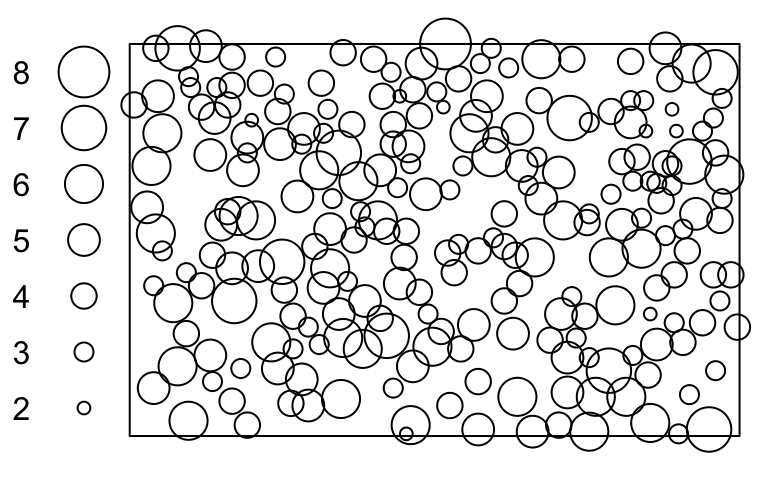
anemones
spatstat.data::anemones |>
spatstat.geom::print.ppp()
# Marked planar point pattern: 231 points
# marks are numeric, of storage type 'integer'
# window: rectangle = [0, 280] x [0, 180] unitsanemones
spatstat.data::anemones |>
spatstat.geom::npoints.ppp()
# [1] 231anemones
spatstat.data::anemones |>
spatstat.geom::Window.ppp()
# window: rectangle = [0, 280] x [0, 180] unitsanemones
list(
summary.stats = spatstat.data::anemones |>
spatstat.geom::marks.ppp() |>
summary.default(),
typeof = spatstat.data::anemones |>
spatstat.geom::marks.ppp() |>
typeof()
)
# $summary.stats
# Min. 1st Qu. Median Mean 3rd Qu. Max.
# 2.000 3.000 4.000 4.294 5.000 8.000
#
# $typeof
# [1] "integer"markformat of anemones
spatstat.data::anemones |>
spatstat.geom::markformat.ppp()
# [1] "vector"antsThe point-pattern (ppp.object, Chapter 27) ants from package spatstat.data (v3.1.9) has (Listing 10.8, Figure 10.2)
'Cataglyphis' and 'Messor' (Listing 10.9);'vector'-markformat.ants
par(mar = c(0,0,0,0))
spatstat.data::ants |>
spatstat.geom::plot.ppp(main = NULL)ants

ants
spatstat.data::ants |>
spatstat.geom::print.ppp()
# Marked planar point pattern: 97 points
# Multitype, with levels = Cataglyphis, Messor
# window: polygonal boundary
# enclosing rectangle: [-25, 803] x [-49, 717] units (one unit = 0.5 feet)ants
spatstat.data::ants |>
spatstat.geom::marks.ppp() |>
table()
#
# Cataglyphis Messor
# 29 68austatesThe tessellation (Chapter 31) austates from package spatstat.data (v3.1.9) has (Listing 10.11, Figure 10.3)
austates
par(mar = c(0,0,1,0))
spatstat.data::austates |>
spatstat.geom::plot.tess()austates
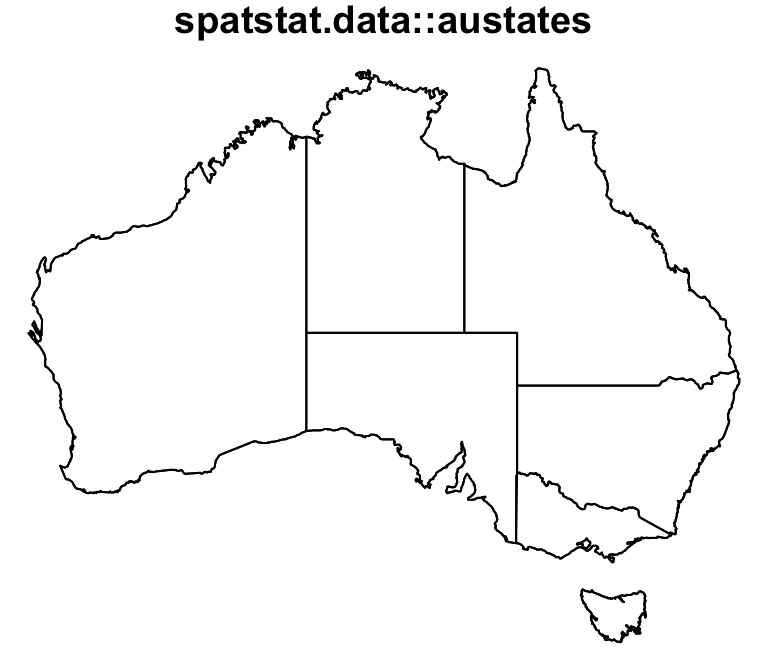
austates
spatstat.data::austates |>
spatstat.geom::print.tess()
# Tessellation
# Tiles are irregular polygons
# 7 tiles (irregular windows)
# window: polygonal boundary
# enclosing rectangle: [113.19392, 153.6692] x [-43.59316, -10.93156] degreesaustates
spatstat.data::austates$tiles
# $WA
# window: polygonal boundary
# enclosing rectangle: [113.19392, 129.01141] x [-35.11407, -13.76426] degrees
#
# $NT
# window: polygonal boundary
# enclosing rectangle: [129.01141, 138.0038] x [-25.988593, -11.045627] degrees
#
# $SA
# window: polygonal boundary
# enclosing rectangle: [129.01141, 141.0076] x [-37.96578, -25.98859] degrees
#
# $QLD
# window: polygonal boundary
# enclosing rectangle: [138.0038, 153.47909] x [-29.163498, -10.931559] degrees
#
# $NSW
# window: polygonal boundary
# enclosing rectangle: [141.0076, 153.6692] x [-37.45247, -28.07985] degrees
#
# $VIC
# window: polygonal boundary
# enclosing rectangle: [140.95057, 149.79087] x [-39.04943, -33.91635] degrees
#
# $TAS
# window: polygonal boundary
# enclosing rectangle: [144.63878, 148.34601] x [-43.59316, -40.58935] degreesbetacellsThe point-pattern (ppp.object, Chapter 27) betacells from package spatstat.data (v3.1.9) has (Listing 10.14, Figure 10.4)
area (Listing 10.16);type with two levels, 'off' and 'on' (Listing 10.16);'dataframe'-markformat (Listing 10.15).betacells
par(mar = c(0,0,1,0))
spatstat.data::betacells |>
spatstat.geom::plot.ppp()betacells
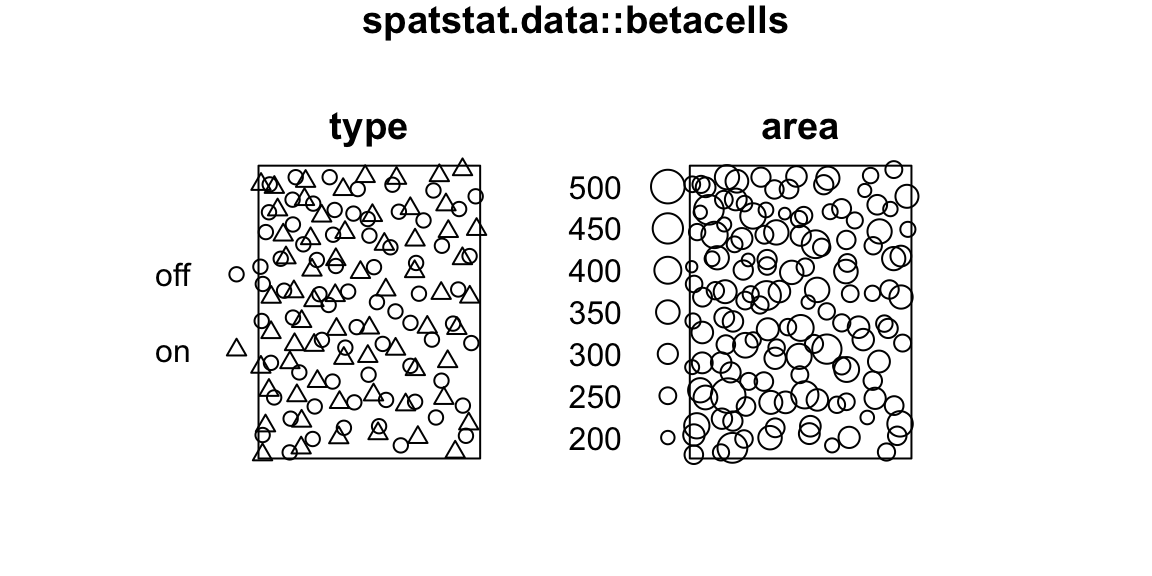
betacells
spatstat.data::betacells |>
spatstat.geom::print.ppp()
# Marked planar point pattern: 135 points
# Mark variables: type, area
# window: rectangle = [28.08, 778.08] x [16.2, 1007.02] micronsmarkformat of betacells
spatstat.data::betacells |>
spatstat.geom::markformat.ppp()
# [1] "dataframe"betacells
spatstat.data::betacells |>
spatstat.geom::marks.ppp() |>
head(n = 3L)
# type area
# 1 on 275.9
# 2 off 241.2
# 3 on 256.0bronzefilterThe point-pattern (ppp.object, Chapter 27) bronzefilter from package spatstat.data (v3.1.9) has (Listing 10.18, Figure 10.5)
bronzefilter
par(mar = c(0,1,0,0))
spatstat.data::bronzefilter |>
spatstat.geom::plot.ppp(main = NULL)bronzefilter
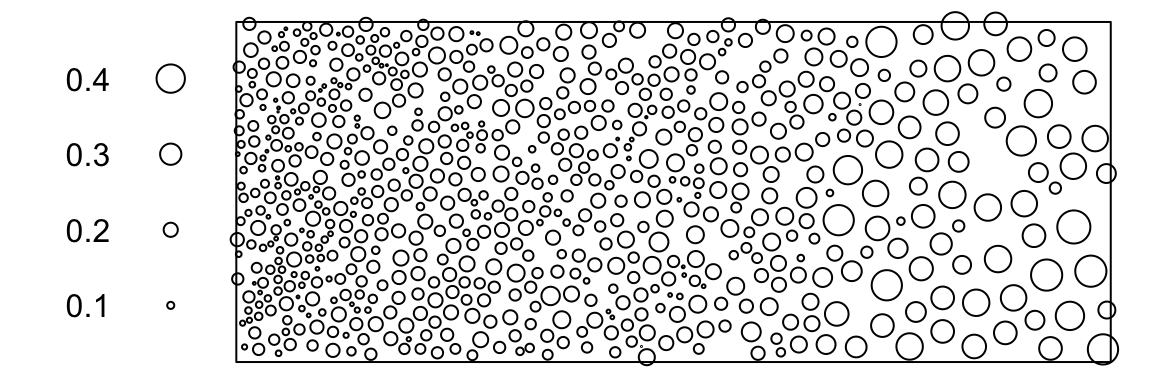
bronzefilter
spatstat.data::bronzefilter |>
spatstat.geom::print.ppp()
# Marked planar point pattern: 678 points
# marks are numeric, of storage type 'double'
# window: rectangle = [0, 18] x [0, 7] mmbtb.extraThe point-pattern list (ppplist, Chapter 28) btb.extra from package spatstat.data (v3.1.9) (Listing 10.20, Figure 10.6)
inherits from the S3 class 'solist' (Chapter 30, Listing 10.21);ppp.object, Chapter 27) members (Listing 10.22).btb.extra
par(mar = c(0,1,1,1))
spatstat.data::btb.extra |>
spatstat.geom::plot.solist() |>
suppressWarnings() |> suppressMessages()btb.extra

btb.extra
spatstat.data::btb.extra
# List of point patterns
#
# full:
# Marked planar point pattern: 919 points
# Mark variables: year, spoligotype
# window: polygonal boundary
# enclosing rectangle: [133.5147, 246.0193] x [10.88514, 118.7298] km
#
# standard:
# Marked planar point pattern: 873 points
# Mark variables: year, spoligotype
# window: polygonal boundary
# enclosing rectangle: [133.5147, 246.0193] x [10.88514, 118.7298] kmbtb.extra
spatstat.data::btb.extra |>
class()
# [1] "ppplist" "solist" "anylist" "listof" "list"class of members of btb.extra
spatstat.data::btb.extra |>
sapply(FUN = class)
# full standard
# "ppp" "ppp"cetaceansThe hyper data frame (hyperframe, Chapter 20) cetaceans from package spatstat.data (v3.1.9) has (Listing 10.23)
ppp, Chapter 27) hypercolumns: $whales, $dolphins, $fish and $plankton. Each point-pattern hypercolumn is a point-pattern list (ppplist, Chapter 28).cetaceans
spatstat.data::cetaceans |>
spatstat.geom::print.hyperframe()
# Hyperframe:
# whales dolphins fish plankton
# 1 (ppp) (ppp) (ppp) (ppp)
# 2 (ppp) (ppp) (ppp) (ppp)
# 3 (ppp) (ppp) (ppp) (ppp)
# 4 (ppp) (ppp) (ppp) (ppp)
# 5 (ppp) (ppp) (ppp) (ppp)
# 6 (ppp) (ppp) (ppp) (ppp)
# 7 (ppp) (ppp) (ppp) (ppp)
# 8 (ppp) (ppp) (ppp) (ppp)
# 9 (ppp) (ppp) (ppp) (ppp)dimensions of cetaceans
spatstat.data::cetaceans |>
spatstat.geom::dim.hyperframe()
# [1] 9 4demohyperThe hyper data frame (hyperframe, Chapter 20) demohyper from package spatstat.data (v3.1.9) has (Listing 10.25)
$Group,ppp, Chapter 27) hypercolumn $Points, andim, Chapter 22) hypercolumn $Image.To view demohyper in a desired format, readers may use either one of the following approaches,
library(spatstat.geom), then call the S3 generic function base::print() by simply typing the object’s name at the console prompt and pressing Enter;library(groupedHyperframe), then call the S3 generic function base::print() by simply typing the object’s name at the console prompt and pressing Enter. This approach works as intended, since package groupedHyperframe (v0.3.2) Imports the package spatstat.geom (v3.6.1);S3 method spatstat.geom::print.hyperframe() directly (Listing 10.25).demohyper
spatstat.data::demohyper |>
spatstat.geom::print.hyperframe()
# Hyperframe:
# Points Image Group
# 1 (ppp) (im) a
# 2 (ppp) (im) b
# 3 (ppp) (im) adimensions of demohyper
spatstat.data::demohyper |>
spatstat.geom::dim.hyperframe()
# [1] 3 3To find the (hyper)column names of demohyper, readers may use either one of the following approaches,
library(spatstat.geom), then call the .Primitive S3 generic function base::names();library(groupedHyperframe), then call the .Primitive S3 generic function base::names(). This approach works as intended, since package groupedHyperframe (v0.3.2) Imports the package spatstat.geom (v3.6.1);S3 method spatstat.geom::names.hyperframe() directly (Listing 10.27).demohyper
spatstat.data::demohyper |>
spatstat.geom::names.hyperframe()
# [1] "Points" "Image" "Group"To observe the ppp-hypercolumn demohyper$Points and the im-hypercolumn demohyper$Image, readers may use either one of the following approaches,
library(spatstat.geom), then call the .Primitive S3 generic function base::`$`;library(groupedHyperframe), then call the .Primitive S3 generic function base::`$`. This approach works as intended, since package groupedHyperframe (v0.3.2) Imports the package spatstat.geom (v3.6.1), as in Listing 10.28;S3 method spatstat.geom::`$.hyperframe` directly (Listing 10.29).ppp-hypercolumn demohyper$Points
spatstat.data::demohyper$Points |>
class()
# [1] "ppplist" "solist" "anylist" "listof" "list"ppp-hypercolumn demohyper$Points, super nerdy way!
spatstat.data::demohyper |>
spatstat.geom::`$.hyperframe`(name = 'Points') |> # only if you know what you are doing!!
class()
# [1] "ppplist" "solist" "anylist" "listof" "list"ppp.object in ppp-hypercolumn demohyper$Pointsspatstat.data::demohyper$Points[[1L]] |>
spatstat.geom::print.ppp()
# Planar point pattern: 104 points
# window: binary image mask
# 128 x 128 pixel array (ny, nx)
# enclosing rectangle: [2.017, 3.93] x [0.645, 3.278] units
if (FALSE) {
spatstat.data::demohyper$Points[[1L]] |>
spatstat.geom::plot.ppp()
} # figure suppressed to reduce vignette sizeim-hypercolumn demohyper$Imagespatstat.data::demohyper$Image
# List of pixel images
#
# 1:
# real-valued pixel image
# 53 x 39 pixel array (ny, nx)
# enclosing rectangle: [2.017, 3.93] x [0.645, 3.278] units
#
# 2:
# real-valued pixel image
# 39 x 53 pixel array (ny, nx)
# enclosing rectangle: [0.645, 3.278] x [2.017, 3.93] units
#
# 3:
# real-valued pixel image
# 39 x 53 pixel array (ny, nx)
# enclosing rectangle: [-3.278, -0.645] x [-3.93, -2.017] units
spatstat.data::demohyper$Image |>
class()
# [1] "imlist" "solist" "anylist" "listof" "list"im.object in im-hypercolumn demohyper$Imagespatstat.data::demohyper$Image[[1L]] |>
spatstat.geom::print.im()
# real-valued pixel image
# 53 x 39 pixel array (ny, nx)
# enclosing rectangle: [2.017, 3.93] x [0.645, 3.278] units
if (FALSE) {
spatstat.data::demohyper$Image[[1L]] |>
spatstat.geom::plot.im()
} # figure suppressed to reduce vignette sizefinpinesThe point-pattern (ppp.object, Chapter 27) finpines from package spatstat.data (v3.1.9) has (Listing 10.31, Figure 10.7)
diameter and height.finpines
par(mar = c(0,0,1,0))
spatstat.data::finpines |>
spatstat.geom::plot.ppp()finpines
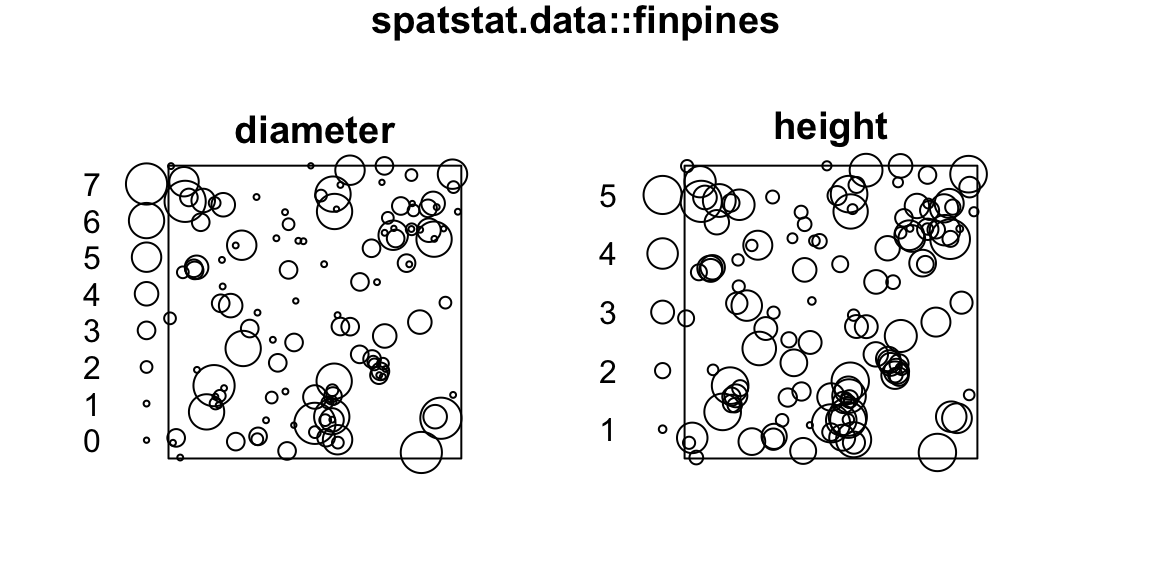
finpines
spatstat.data::finpines |>
spatstat.geom::print.ppp()
# Marked planar point pattern: 126 points
# Mark variables: diameter, height
# window: rectangle = [-5, 5] x [-8, 2] metresfluThe hyper data frame (hyperframe, Chapter 20) flu from package spatstat.data (v3.1.9) has (Listing 10.32)
ppp, Chapter 27) hypercolumn $pattern, which is a point-pattern list (ppplist, Chapter 28);$virustype, $stain, $frameidflu
spatstat.data::flu |>
spatstat.geom::print.hyperframe()
# Hyperframe:
# pattern virustype stain frameid
# wt M2-M1 13 (ppp) wt M2-M1 13
# wt M2-M1 22 (ppp) wt M2-M1 22
# wt M2-M1 27 (ppp) wt M2-M1 27
# wt M2-M1 43 (ppp) wt M2-M1 43
# wt M2-M1 49 (ppp) wt M2-M1 49
# wt M2-M1 65 (ppp) wt M2-M1 65
# wt M2-M1 71 (ppp) wt M2-M1 71
# wt M2-M1 84 (ppp) wt M2-M1 84
# wt M2-HA 3 (ppp) wt M2-HA 3
# wt M2-HA 4 (ppp) wt M2-HA 4
# wt M2-HA 5 (ppp) wt M2-HA 5
# wt M2-HA 17 (ppp) wt M2-HA 17
# wt M2-HA 54 (ppp) wt M2-HA 54
# wt M2-HA 74 (ppp) wt M2-HA 74
# wt M2-HA 78 (ppp) wt M2-HA 78
# wt M2-HA 82 (ppp) wt M2-HA 82
# wt M2-HA 85 (ppp) wt M2-HA 85
# wt M2-HA 100 (ppp) wt M2-HA 100
# wt M2-HA 110 (ppp) wt M2-HA 110
# mut1 M2-M1 11 (ppp) mut1 M2-M1 11
# mut1 M2-M1 13 (ppp) mut1 M2-M1 13
# mut1 M2-M1 15 (ppp) mut1 M2-M1 15
# mut1 M2-M1 17 (ppp) mut1 M2-M1 17
# mut1 M2-M1 28 (ppp) mut1 M2-M1 28
# mut1 M2-M1 29 (ppp) mut1 M2-M1 29
# mut1 M2-M1 33 (ppp) mut1 M2-M1 33
# mut1 M2-M1 38 (ppp) mut1 M2-M1 38
# mut1 M2-M1 41 (ppp) mut1 M2-M1 41
# mut1 M2-M1 44 (ppp) mut1 M2-M1 44
# mut1 M2-M1 59 (ppp) mut1 M2-M1 59
# mut1 M2-HA 8 (ppp) mut1 M2-HA 8
# mut1 M2-HA 14 (ppp) mut1 M2-HA 14
# mut1 M2-HA 23 (ppp) mut1 M2-HA 23
# mut1 M2-HA 42 (ppp) mut1 M2-HA 42
# mut1 M2-HA 51 (ppp) mut1 M2-HA 51
# mut1 M2-HA 59 (ppp) mut1 M2-HA 59
# mut1 M2-HA 73 (ppp) mut1 M2-HA 73
# mut1 M2-HA 79 (ppp) mut1 M2-HA 79
# mut1 M2-HA 86 (ppp) mut1 M2-HA 86
# mut1 M2-HA 104 (ppp) mut1 M2-HA 104
# mut1 M2-HA 147 (ppp) mut1 M2-HA 147dimensions of flu
spatstat.data::flu |>
spatstat.geom::dim.hyperframe()
# [1] 41 4gorillasThe point-pattern (ppp.object, Chapter 27) gorillas from package spatstat.data (v3.1.9) has (Listing 10.35, Figure 10.8)
$group (with two levels 'major' and 'minor') and $season (with two levels 'dry' and 'rainy').gorillas
par(mar = c(0,0,1,0))
spatstat.data::gorillas |>
spatstat.geom::plot.ppp(which.marks = c('group', 'season'))gorillas

gorillas
spatstat.data::gorillas |>
spatstat.geom::print.ppp()
# Marked planar point pattern: 647 points
# Mark variables: group, season, date
# window: polygonal boundary
# enclosing rectangle: [580457.9, 585934] x [674172.8, 678739.2] metresgorillas.extraThe pixel-image list (imlist, Chapter 23) gorillas.extra from package spatstat.data (v3.1.9) (Listing 10.37, Figure 10.9)
inherits from the S3 class 'solist' (Chapter 30, Listing 10.38);im, Chapter 22) members (Listing 10.39).gorillas.extra
par(mar = c(0,1,1,1))
spatstat.data::gorillas.extra |>
plot() |>
suppressWarnings() |> suppressMessages()gorillas.extra

gorillas.extra
spatstat.data::gorillas.extra
# List of pixel images
#
# aspect:
# factor-valued pixel image
# factor levels:
# [1] "N" "NE" "E" "SE" "S" "SW" "W" "NW"
# 149 x 181 pixel array (ny, nx)
# enclosing rectangle: [580440, 586000] x [674160, 678730] metres
#
# elevation:
# integer-valued pixel image
# 149 x 181 pixel array (ny, nx)
# enclosing rectangle: [580440, 586000] x [674160, 678730] metres
#
# heat:
# factor-valued pixel image
# factor levels:
# [1] "Warmest" "Moderate" "Coolest"
# 149 x 181 pixel array (ny, nx)
# enclosing rectangle: [580440, 586000] x [674160, 678730] metres
#
# slopeangle:
# real-valued pixel image
# 149 x 181 pixel array (ny, nx)
# enclosing rectangle: [580440, 586000] x [674160, 678730] metres
#
# slopetype:
# factor-valued pixel image
# factor levels:
# [1] "Valley" "Toe" "Flat" "Midslope" "Upper" "Ridge"
# 149 x 181 pixel array (ny, nx)
# enclosing rectangle: [580440, 586000] x [674160, 678730] metres
#
# vegetation:
# factor-valued pixel image
# factor levels:
# [1] "Disturbed" "Colonising" "Grassland" "Primary" "Secondary" "Transition"
# 149 x 181 pixel array (ny, nx)
# enclosing rectangle: [580440, 586000] x [674160, 678730] metres
#
# waterdist:
# real-valued pixel image
# 149 x 181 pixel array (ny, nx)
# enclosing rectangle: [580440, 586000] x [674160, 678730] metresgorillas.extra
spatstat.data::gorillas.extra |>
class()
# [1] "imlist" "solist" "anylist" "listof" "list"class of members of gorillas.extra
spatstat.data::gorillas.extra |>
sapply(FUN = class)
# aspect elevation heat slopeangle slopetype vegetation waterdist
# "im" "im" "im" "im" "im" "im" "im"KovesiThe hyper data frame (hyperframe, Chapter 20) Kovesi from package spatstat.data (v3.1.9) has (Listing 10.40)
$linear, $diverging, etc.character hypercolumn $values, which is a list of character vectors (anylist, Chapter 13)Kovesi
spatstat.data::Kovesi |>
spatstat.geom::print.hyperframe()
# Hyperframe:
# linear diverging rainbow cyclic isoluminant ternary colsig l1 l2 chro n cycsh values
# 1 FALSE FALSE FALSE TRUE FALSE FALSE j 15 85 0 256 0 (character)
# 2 FALSE FALSE FALSE TRUE FALSE FALSE j 15 85 0 256 25 (character)
# 3 FALSE FALSE FALSE TRUE FALSE FALSE mrybm 35 75 68 256 0 (character)
# 4 FALSE FALSE FALSE TRUE FALSE FALSE mrybm 35 75 68 256 25 (character)
# 5 FALSE FALSE FALSE TRUE FALSE FALSE mygbm 30 95 78 256 0 (character)
# 6 FALSE FALSE FALSE TRUE FALSE FALSE mygbm 30 95 78 256 25 (character)
# 7 FALSE FALSE FALSE TRUE FALSE FALSE wrwbw 40 90 42 256 0 (character)
# 8 FALSE FALSE FALSE TRUE FALSE FALSE wrwbw 40 90 42 256 25 (character)
# 9 FALSE TRUE FALSE FALSE FALSE FALSE bkr 55 10 35 256 0 (character)
# 10 FALSE TRUE FALSE FALSE FALSE FALSE bky 60 10 30 256 0 (character)
# 11 FALSE TRUE FALSE FALSE FALSE FALSE bwr 40 95 42 256 0 (character)
# 12 FALSE TRUE FALSE FALSE FALSE FALSE bwr 55 98 37 256 0 (character)
# 13 FALSE TRUE FALSE FALSE FALSE FALSE cwm 80 100 22 256 0 (character)
# 14 FALSE TRUE FALSE FALSE FALSE FALSE gkr 60 10 40 256 0 (character)
# 15 FALSE TRUE FALSE FALSE FALSE FALSE gwr 55 95 38 256 0 (character)
# 16 FALSE TRUE FALSE FALSE FALSE FALSE gwv 55 95 39 256 0 (character)
# 17 FALSE TRUE FALSE FALSE TRUE FALSE cjm 75 75 24 256 0 (character)
# 18 FALSE TRUE FALSE FALSE TRUE FALSE cjo 70 70 25 256 0 (character)
# 19 TRUE TRUE FALSE FALSE FALSE FALSE bjr 30 55 53 256 0 (character)
# 20 TRUE TRUE FALSE FALSE FALSE FALSE bjy 30 90 45 256 0 (character)
# 21 FALSE TRUE TRUE FALSE FALSE FALSE bgymr 45 85 67 256 0 (character)
# 22 FALSE FALSE FALSE FALSE TRUE FALSE cgo 70 70 39 256 0 (character)
# 23 FALSE FALSE FALSE FALSE TRUE FALSE cgo 80 80 38 256 0 (character)
# 24 FALSE FALSE FALSE FALSE TRUE FALSE cm 70 70 39 256 0 (character)
# 25 TRUE FALSE FALSE FALSE FALSE FALSE b 5 95 73 256 0 (character)
# 26 TRUE FALSE FALSE FALSE FALSE FALSE b 95 50 20 256 0 (character)
# 27 TRUE FALSE FALSE FALSE FALSE FALSE bgy 10 95 74 256 0 (character)
# 28 TRUE FALSE FALSE FALSE FALSE FALSE bmw 5 95 89 256 0 (character)
# 29 TRUE FALSE FALSE FALSE FALSE FALSE bmy 10 95 78 256 0 (character)
# 30 TRUE FALSE FALSE FALSE FALSE FALSE g 5 95 69 256 0 (character)
# 31 TRUE FALSE FALSE FALSE FALSE FALSE gow 60 85 27 256 0 (character)
# 32 TRUE FALSE FALSE FALSE FALSE FALSE gow 65 90 35 256 0 (character)
# 33 TRUE FALSE FALSE FALSE FALSE FALSE j 0 100 0 256 0 (character)
# 34 TRUE FALSE FALSE FALSE FALSE FALSE j 10 95 0 256 0 (character)
# 35 TRUE FALSE FALSE FALSE FALSE FALSE kry 5 98 75 256 0 (character)
# 36 TRUE FALSE FALSE FALSE FALSE FALSE kryw 5 100 67 256 0 (character)
# 37 TRUE FALSE FALSE FALSE FALSE TRUE b 0 44 57 256 0 (character)
# 38 TRUE FALSE FALSE FALSE FALSE TRUE g 0 46 42 256 0 (character)
# 39 TRUE FALSE FALSE FALSE FALSE TRUE r 0 50 52 256 0 (character)
# 40 FALSE FALSE TRUE FALSE FALSE FALSE bgyr 35 85 73 256 0 (character)
# 41 FALSE FALSE TRUE FALSE FALSE FALSE bgyrm 35 85 71 256 0 (character)dimensions of Kovesi
spatstat.data::Kovesi |>
spatstat.geom::dim.hyperframe()
# [1] 41 13longleafThe point-pattern (ppp.object, Chapter 27) longleaf from package spatstat.data (v3.1.9) has (Listing 10.43, Figure 10.10)
longleaf
par(mar = c(0,0,0,0))
spatstat.data::longleaf |>
spatstat.geom::plot.ppp(main = NULL)longleaf

longleaf
spatstat.data::longleaf |>
spatstat.geom::print.ppp()
# Marked planar point pattern: 584 points
# marks are numeric, of storage type 'double'
# window: rectangle = [0, 200] x [0, 200] metresnbfiresThe point-pattern (ppp.object, Chapter 27) nbfires from package spatstat.data (v3.1.9) has (Listing 10.45, Figure 10.11)
$fire.type, $cause and $ign.src;$fnl.size.nbfires
par(mar = c(0,0,1,0))
spatstat.data::nbfires |>
spatstat.geom::plot.ppp(which.marks = c('fire.type', 'cause', 'ign.src', 'fnl.size'))
# Warning: Only 10 out of 16 symbols are shown in the symbol mapnbfires
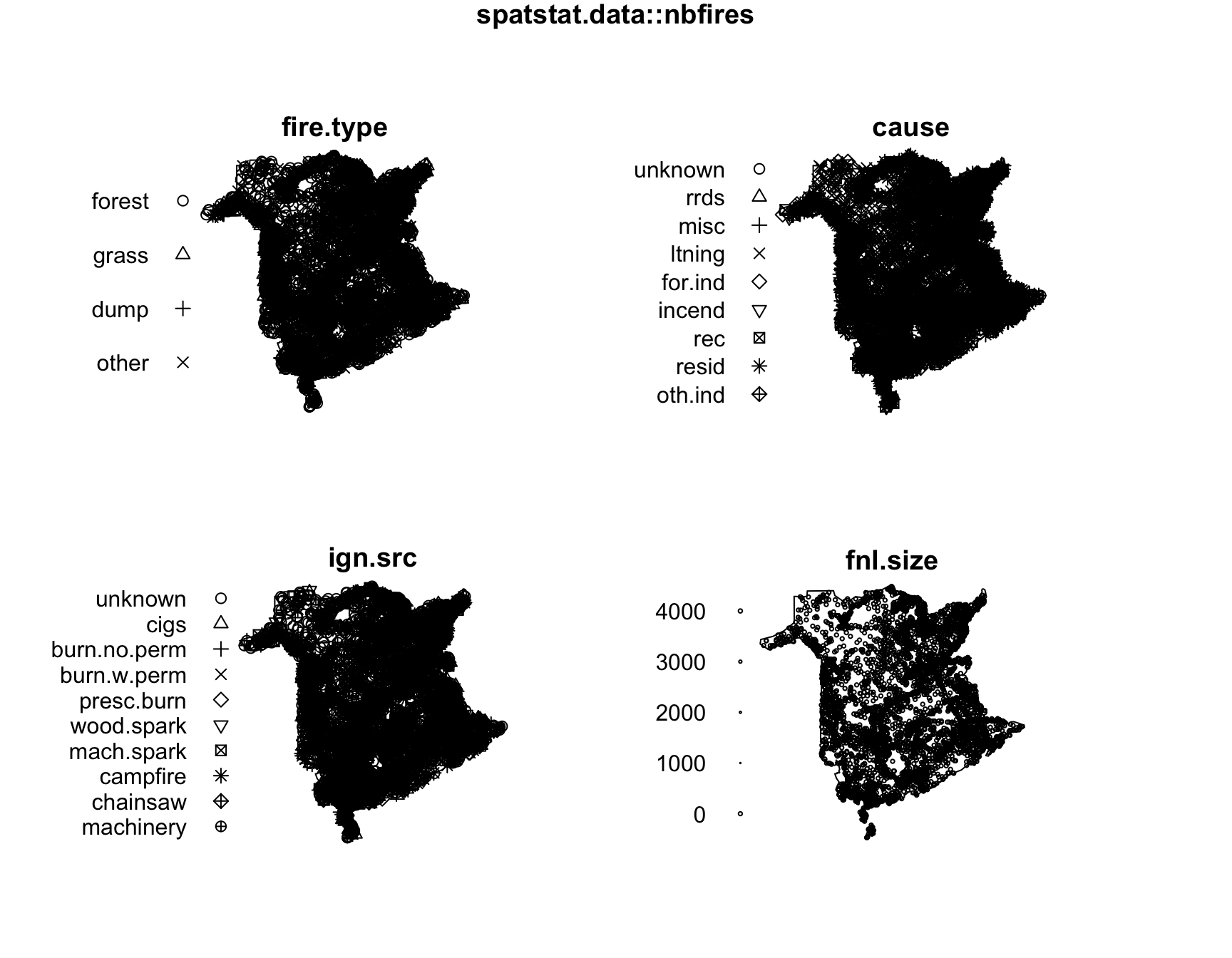
nbfires
spatstat.data::nbfires |>
spatstat.geom::print.ppp()
# Warning: some mark values are NA in the point pattern x
# Marked planar point pattern: 7108 points
# Mark variables: year, fire.type, dis.date, dis.julian, out.date, out.julian, cause, ign.src, fnl.size
# window: polygonal boundary
# enclosing rectangle: [0, 1000] x [0, 958.9142] units (one unit = 0.403716 km)osteoThe hyper data frame (hyperframe, Chapter 20) osteo from package spatstat.data (v3.1.9) has (Listing 10.46)
$brick nested in the bone sample $idpp3, Chapter 26) hypercolumn $ptsosteo
spatstat.data::osteo |>
spatstat.geom::print.hyperframe()
# Hyperframe:
# id shortid brick pts depth
# 1 c77za4 4 1 (pp3) 45
# 2 c77za4 4 2 (pp3) 60
# 3 c77za4 4 3 (pp3) 55
# 4 c77za4 4 4 (pp3) 60
# 5 c77za4 4 5 (pp3) 85
# 6 c77za4 4 6 (pp3) 90
# 7 c77za4 4 7 (pp3) 95
# 8 c77za4 4 8 (pp3) 65
# 9 c77za4 4 9 (pp3) 100
# 10 c77za4 4 10 (pp3) 100
# 11 c77za5 5 1 (pp3) 45
# 21 c77za5 5 2 (pp3) 30
# 31 c77za5 5 3 (pp3) 40
# 41 c77za5 5 4 (pp3) 45
# 51 c77za5 5 5 (pp3) 40
# 61 c77za5 5 6 (pp3) 50
# 71 c77za5 5 7 (pp3) 40
# 81 c77za5 5 8 (pp3) 60
# 91 c77za5 5 9 (pp3) 65
# 101 c77za5 5 10 (pp3) 60
# 12 c77za8 8 1 (pp3) 40
# 22 c77za8 8 2 (pp3) 55
# 32 c77za8 8 3 (pp3) 60
# 42 c77za8 8 4 (pp3) 50
# 52 c77za8 8 5 (pp3) 45
# 62 c77za8 8 6 (pp3) 30
# 72 c77za8 8 7 (pp3) 50
# 82 c77za8 8 8 (pp3) 45
# 92 c77za8 8 9 (pp3) 70
# 102 c77za8 8 10 (pp3) 110
# 13 c77za9 9 1 (pp3) 60
# 23 c77za9 9 2 (pp3) 65
# 33 c77za9 9 3 (pp3) 55
# 43 c77za9 9 4 (pp3) 70
# 53 c77za9 9 5 (pp3) 55
# 63 c77za9 9 6 (pp3) 100
# 73 c77za9 9 7 (pp3) 80
# 83 c77za9 9 8 (pp3) 75
# 93 c77za9 9 9 (pp3) 85
# 103 c77za9 9 10 (pp3) 60dimensions of osteo
spatstat.data::osteo |>
spatstat.geom::dim.hyperframe()
# [1] 40 5sprucesThe point-pattern (ppp.object, Chapter 27) spruces from package spatstat.data (v3.1.9) has (Listing 10.49, Figure 10.12)
spruces
par(mar = c(0,0,0,0))
spatstat.data::spruces |>
spatstat.geom::plot.ppp(main = NULL)spruces

spruces
spatstat.data::spruces |>
spatstat.geom::print.ppp()
# Marked planar point pattern: 134 points
# marks are numeric, of storage type 'double'
# window: rectangle = [0, 56] x [0, 38] metresswedishpinesThe point-pattern (ppp.object, Chapter 27) swedishpines from package spatstat.data (v3.1.9) has (Listing 10.51, Figure 10.13)
'none'-markformat.swedishpines
par(mar = c(0,0,0,0))
spatstat.data::swedishpines |>
spatstat.geom::plot.ppp(main = NULL)swedishpines

swedishpines
spatstat.data::swedishpines |>
spatstat.geom::print.ppp()
# Planar point pattern: 71 points
# window: rectangle = [0, 96] x [0, 100] units (one unit = 0.1 metres)vesiclesThe point-pattern (ppp.object, Chapter 27) vesicles from package spatstat.data (v3.1.9) has (Listing 10.53, Figure 10.14)
'none'-markformat.vesicles
par(mar = c(0,0,0,0))
spatstat.data::vesicles |>
spatstat.geom::plot.ppp(main = NULL)vesicles

vesicles
spatstat.data::vesicles |>
spatstat.geom::print.ppp()
# Planar point pattern: 37 points
# window: polygonal boundary
# enclosing rectangle: [22.6796, 586.2292] x [11.9756, 1030.7] nmvesicles.extraThe spatial object list (solist, Chapter 30) vesicles.extra from package spatstat.data (v3.1.9) has (Listing 10.54, Listing 10.55)
psp, Chapter 29) $activezone$mitochondria, $presynapse and $maskvesicles.extra
spatstat.data::vesicles.extra
# List of spatial objects
#
# activezone:
# planar line segment pattern: 9 line segments
# window: rectangle = [0, 625] x [0, 1050] nm
#
# mitochondria:
# window: polygonal boundary
# enclosing rectangle: [90.41389, 315.29187] x [532.1753, 781.4376] nm
#
# presynapse:
# window: polygonal boundary
# enclosing rectangle: [22.6796, 586.2292] x [11.9756, 1030.7] nm
#
# mask:
# window: binary image mask
# 420 x 250 pixel array (ny, nx)
# enclosing rectangle: [0, 250] x [0, 420] unitsclass of members of vesicles.extra
spatstat.data::vesicles.extra |>
lapply(FUN = class)
# $activezone
# [1] "psp" "list"
#
# $mitochondria
# [1] "owin"
#
# $presynapse
# [1] "owin"
#
# $mask
# [1] "owin"waterstridersThe point-pattern list (ppplist, Chapter 28) waterstriders from package spatstat.data (v3.1.9) (Listing 10.57, Figure 10.15)
inherits from the S3 class 'solist' (Chapter 30)ppp.object, Chapter 27) members (Listing 10.58).waterstriders
par(mar = c(0,1,1,1))
spatstat.data::waterstriders |>
spatstat.geom::plot.solist()waterstriders
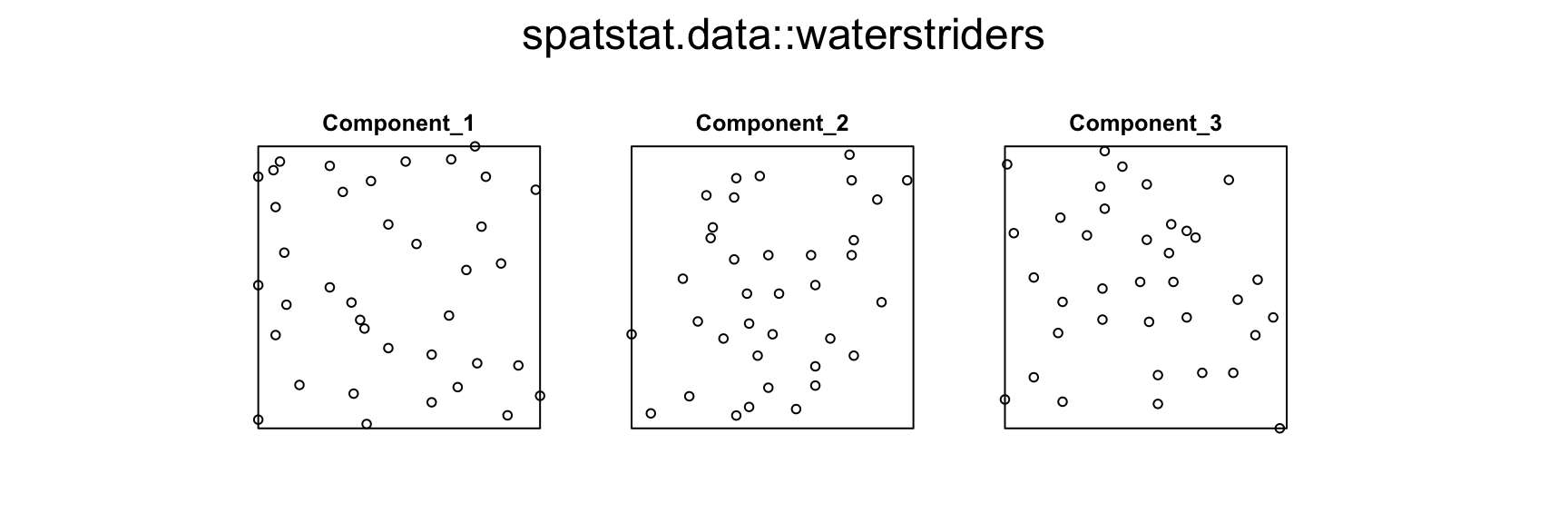
waterstriders
spatstat.data::waterstriders
# List of point patterns
#
# Component 1:
# Planar point pattern: 38 points
# window: rectangle = [0, 48.1] x [0, 48.1] cm
#
# Component 2:
# Planar point pattern: 36 points
# window: rectangle = [0, 48.8] x [0, 48.8] cm
#
# Component 3:
# Planar point pattern: 36 points
# window: rectangle = [0, 46.4] x [0, 46.4] cmclass of members of waterstriders
spatstat.data::waterstriders |>
sapply(FUN = class)
# [1] "ppp" "ppp" "ppp"